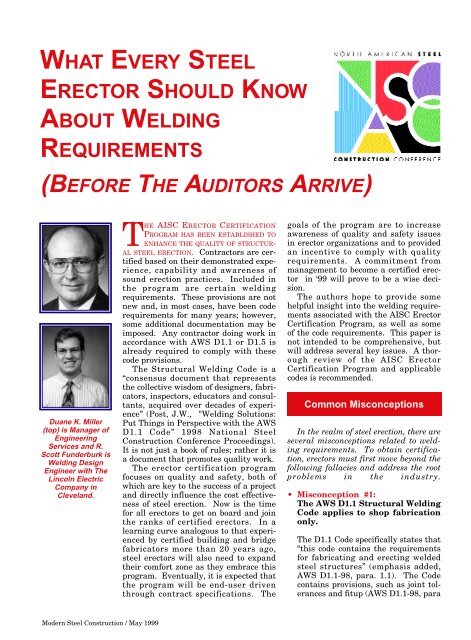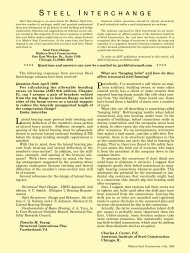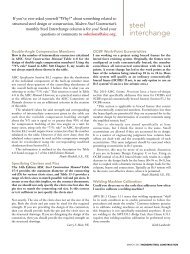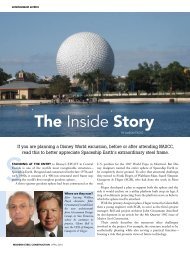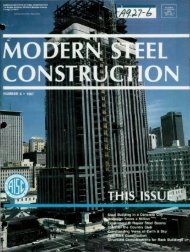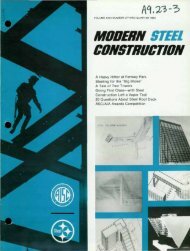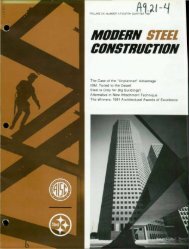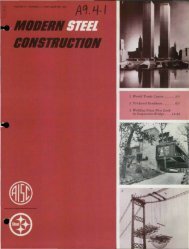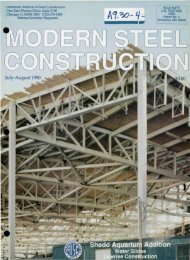what every steel erector should know about welding ... - AISC
what every steel erector should know about welding ... - AISC
what every steel erector should know about welding ... - AISC
Create successful ePaper yourself
Turn your PDF publications into a flip-book with our unique Google optimized e-Paper software.
WHAT EVERY STEEL<br />
ERECTOR SHOULD KNOW<br />
ABOUT WELDING<br />
REQUIREMENTS<br />
(BEFORE THE AUDITORS ARRIVE)<br />
Duane K. Miller<br />
(top) is Manager of<br />
Engineering<br />
Services and R.<br />
Scott Funderburk is<br />
Welding Design<br />
Engineer with The<br />
Lincoln Electric<br />
Company in<br />
Cleveland.<br />
Modern Steel Construction / May 1999<br />
THE <strong>AISC</strong> ERECTOR CERTIFICATION<br />
PROGRAM HAS BEEN ESTABLISHED TO<br />
ENHANCE THE QUALITY OF STRUCTUR-<br />
AL STEEL ERECTION. Contractors are certified<br />
based on their demonstrated experience,<br />
capability and awareness of<br />
sound erection practices. Included in<br />
the program are certain <strong>welding</strong><br />
requirements. These provisions are not<br />
new and, in most cases, have been code<br />
requirements for many years; however,<br />
some additional documentation may be<br />
imposed. Any contractor doing work in<br />
accordance with AWS D1.1 or D1.5 is<br />
already required to comply with these<br />
code provisions.<br />
The Structural Welding Code is a<br />
“consensus document that represents<br />
the collective wisdom of designers, fabricators,<br />
inspectors, educators and consultants,<br />
acquired over decades of experience”<br />
(Post, J.W., "Welding Solutions:<br />
Put Things in Perspective with the AWS<br />
D1.1 Code” 1998 National Steel<br />
Construction Conference Proceedings).<br />
It is not just a book of rules; rather it is<br />
a document that promotes quality work.<br />
The <strong>erector</strong> certification program<br />
focuses on quality and safety, both of<br />
which are key to the success of a project<br />
and directly influence the cost effectiveness<br />
of <strong>steel</strong> erection. Now is the time<br />
for all <strong>erector</strong>s to get on board and join<br />
the ranks of certified <strong>erector</strong>s. In a<br />
learning curve analogous to that experienced<br />
by certified building and bridge<br />
fabricators more than 20 years ago,<br />
<strong>steel</strong> <strong>erector</strong>s will also need to expand<br />
their comfort zone as they embrace this<br />
program. Eventually, it is expected that<br />
the program will be end-user driven<br />
through contract specifications. The<br />
goals of the program are to increase<br />
awareness of quality and safety issues<br />
in <strong>erector</strong> organizations and to provided<br />
an incentive to comply with quality<br />
requirements. A commitment from<br />
management to become a certified <strong>erector</strong><br />
in ‘99 will prove to be a wise decision.<br />
The authors hope to provide some<br />
helpful insight into the <strong>welding</strong> requirements<br />
associated with the <strong>AISC</strong> Erector<br />
Certification Program, as well as some<br />
of the code requirements. This paper is<br />
not intended to be comprehensive, but<br />
will address several key issues. A thorough<br />
review of the <strong>AISC</strong> Erector<br />
Certification Program and applicable<br />
codes is recommended.<br />
Common Misconceptions<br />
In the realm of <strong>steel</strong> erection, there are<br />
several misconceptions related to <strong>welding</strong><br />
requirements. To obtain certification,<br />
<strong>erector</strong>s must first move beyond the<br />
following fallacies and address the root<br />
problems in the industry.<br />
• Misconception #1:<br />
The AWS D1.1 Structural Welding<br />
Code applies to shop fabrication<br />
only.<br />
The D1.1 Code specifically states that<br />
“this code contains the requirements<br />
for fabricating and erecting welded<br />
<strong>steel</strong> structures” (emphasis added,<br />
AWS D1.1-98, para. 1.1). The Code<br />
contains provisions, such as joint tolerances<br />
and fitup (AWS D1.1-98, para
5.22), that must be followed regardless<br />
of where the <strong>welding</strong> is done. In<br />
fact, many of the sections were written<br />
with field erection in mind. For<br />
example, if the root opening on a<br />
groove weld exceeds the “as-fit” tolerances,<br />
the Code provides options for<br />
resolution of this problem (AWS<br />
D1.1-98, para. 5.22.4.3 and 5.22.4.4).<br />
It is speculated that these provisions<br />
are used more frequently in the field<br />
than in the shop.<br />
The D1.1 Code is equally applicable<br />
to both shop fabrication and field construction.<br />
Misconception #2:<br />
If a prequalified <strong>welding</strong> procedure<br />
is used, then a written WPS<br />
is not required.<br />
The D1.1 Code mandates that “all<br />
prequalified WPSs shall be written”<br />
(D1.1-98, para. 3.1). Welding<br />
Procedure Specifications are the communication<br />
tool that gives the welder<br />
instructions on how to make the<br />
weld. Items such as minimum preheat<br />
temperature, maximum interpass<br />
temperature and bead placement<br />
are listed on the WPS and must<br />
be maintained to obtain the required<br />
weld soundness and mechanical properties.<br />
More information on WPS<br />
development is included in in<br />
"Reviewing and Approving Welding<br />
Procedure Specifications" (Miller and<br />
Funderburk, NSCC 1998) and "What<br />
Every Engineer Needs to Know About<br />
Welding Procedures" (Miller, NSCC<br />
1997).<br />
Written WPSs are required for all<br />
<strong>welding</strong>, including prequalified procedures.<br />
Misconception #3:<br />
Quality Assurance will handle all<br />
of the field inspection issues – the<br />
contractor does not need to do<br />
any inspection.<br />
Both the AWS D1.1 and D1.5 Codes<br />
specifically define inspection responsibilities<br />
for the contractor. D1.1<br />
names the “Fabrication/Erection<br />
Inspector” as the designated person<br />
who acts on behalf of the contractor<br />
with regard to all inspection and<br />
quality matters (AWS D1.1-98, para.<br />
6.1.3.1). D1.1 also says that fabrication/erection<br />
inspection “shall be per-<br />
formed as necessary prior to assembly,<br />
during assembly, during <strong>welding</strong>,<br />
and after <strong>welding</strong> to ensure that<br />
material and workmanship meet the<br />
requirements of the contract documents.<br />
Fabrication/erection inspection<br />
and testing are the responsibilities<br />
of the contractor unless<br />
otherwise provided in the contract<br />
documents”(AWS D1.1-98, para.<br />
6.1.2.1). AWS D1.5 mandates that<br />
the Quality Control (QC) function is<br />
the responsibility of the <strong>erector</strong> (AWS<br />
D1.5-96, para. 6.1.1.1), and the QC<br />
Inspector works on behalf of the <strong>erector</strong><br />
for inspection, testing and quality<br />
matters (AWS D1.5-96, para. 6.1.2.1).<br />
For many field projects, the contract<br />
will require Verification or Quality<br />
Assurance (QA) Inspection, often<br />
stipulating that NDT be performed<br />
by the Verification Inspector (AWS<br />
D1.1-98, 6.1.2.2). This does not, however,<br />
preclude or replace the QC<br />
Inspection that is required by the<br />
Code. For more information on this<br />
issue, the authors recommend<br />
“Ensuring Weld Quality in Structural<br />
Applications: The Roles of Engineers,<br />
Fabricators and Inspectors (Part I of<br />
III)” (Miller, NASCC 1996).<br />
The contractor is responsible for erection<br />
inspection and testing, unless<br />
specifically exempted by the contract<br />
documents.<br />
Misconception #4:<br />
The union hall takes care of all<br />
the welder qualification issues.<br />
Indeed, unions do provide a valuable<br />
service to the industry through their<br />
welder training and testing programs.<br />
Welders can even become certified<br />
welders through the AWS<br />
Welder Certification Program.<br />
However, in terms of the AWS D1.1<br />
Code, it is the contractor’s responsibility<br />
to qualify all welders, <strong>welding</strong><br />
operators, stud welders and tack<br />
welders (AWS D1.1-98, para. 4.1.2.2<br />
and 7.7.4). If a welder was qualified<br />
on a previous job, that performance<br />
qualification may be acceptable provided<br />
that proper documentation and<br />
evidence has been maintained and<br />
that the Engineer, not the contractor,<br />
approves it (AWS D1.1-98, para.<br />
4.1.2.1).<br />
Welder qualification is the contractor’s<br />
responsibility.<br />
The authors would<br />
like to thank Tom<br />
Schlafly of <strong>AISC</strong>,<br />
Inc. and Farnham<br />
Jarrard, Clare<br />
Ulstad and Art<br />
Arndt of the Quality<br />
Auditing Company,<br />
Inc. for their valu-<br />
able input on this<br />
paper, as well as for<br />
their diligent contri-<br />
butions to the<br />
structural <strong>steel</strong><br />
industry for many<br />
years.<br />
Modern Steel Construction / May 1999
To improve quality and safety,<br />
it is important that these misconceptions<br />
be exposed and corrected.<br />
These misunderstandings<br />
can lead to other problems,<br />
such as those discussed below, if<br />
they are not addressed.<br />
Specific Audit<br />
Problems<br />
The acceptance criteria of the<br />
audit are categorized in three<br />
areas: Application (Ap),<br />
Management (Mg) and<br />
Operations (Op). These criteria<br />
have requirements related to all<br />
aspects of <strong>steel</strong> erection, including<br />
<strong>welding</strong>. Based on results<br />
from initial audits, nonconformance<br />
has been found in the following:<br />
Welding Procedure<br />
Specifications, quality control,<br />
welder qualification and other<br />
miscellaneous <strong>welding</strong> issues.<br />
To aid the <strong>erector</strong> in the certification<br />
process, each “problem<br />
item” is quoted from the <strong>AISC</strong><br />
Certified Advanced Steel Erector<br />
Evaluation Checklist with examples<br />
of auditor citations of specific<br />
requirements. A few of the<br />
requirements are for “Advanced”<br />
Certification only, and these are<br />
noted in the applicable sections<br />
below.<br />
WELDING PROCEDURE<br />
SPECIFICATIONS<br />
Are representative weld<br />
procedures submitted?<br />
(<strong>AISC</strong>, Ap10)<br />
“Erector did not submit any<br />
WPSs.”<br />
The contractor must have<br />
WPSs that cover <strong>every</strong> weld to<br />
be made on the job, and the <strong>erector</strong><br />
must submit several to the<br />
auditors for review. Also, an<br />
inspector or the Engineer could<br />
ask to review the WPSs at any<br />
time (AWS D1.1-98, para. 4.1.1,<br />
4.2.3 and 6.3.1). Therefore,<br />
WPSs <strong>should</strong> be kept current, in<br />
Modern Steel Construction / May 1999<br />
use by the welders and ready for<br />
submission. It also makes good<br />
business sense, because complete<br />
and proper WPSs generally<br />
encourage quality and productivity.<br />
“No <strong>steel</strong> specification or grade<br />
was listed on the WPS.”<br />
In this case, the WPS was submitted,<br />
but it was incomplete.<br />
One of the essential variables is<br />
the base metal specification and<br />
grade (AWS D1.1-98, para.<br />
4.7.3); this information must be<br />
explicitly stated on the WPS.<br />
Other examples of incomplete<br />
or incorrect WPSs are the following:<br />
polarity not listed, no date<br />
shown, backing to be used without<br />
the backing material designated,<br />
no supporting PQRs for<br />
qualified procedures, and prequalified<br />
status declared with a<br />
non-prequalified process (e.g.,<br />
GMAW short circuiting).<br />
· Are approved written<br />
<strong>welding</strong> procedures in<br />
close proximity to and<br />
used by the welders?<br />
(<strong>AISC</strong>, Advanced Program<br />
Only — Op444)<br />
“The WPS was for E7018, and<br />
the welder was using E71T-8.”<br />
In this example, either the<br />
welder had the wrong WPS or he<br />
was violating the WPS he was<br />
using. Whichever was the case,<br />
<strong>what</strong> the welder was doing did<br />
not match the requirements of<br />
the WPS. The auditors will<br />
often verify that the actual <strong>welding</strong><br />
is in conformance with the<br />
WPS.<br />
“The WPSs were not at the job<br />
site — apparently they are kept<br />
at the home office.”<br />
The home office is not “in close<br />
proximity” to the welder. One of<br />
the key objectives for WPSs is to<br />
clearly communicate the requirements<br />
to the welder and inspectors.<br />
This can not effectively<br />
take place with the instructions<br />
filed away at the office. The<br />
Code does not say that the<br />
welder must keep the WPS with<br />
him at all times. However, the<br />
welder <strong>should</strong> have quick access<br />
to it. On most job sites, the field<br />
office trailer is an adequate location<br />
for storage of the WPSs. On<br />
some projects, however, the trailer<br />
may be too far away for the<br />
<strong>welding</strong> crew to readily retrieve<br />
the documents. In this case, it<br />
may be more appropriate to<br />
issue a set of WPSs to each crew.<br />
The WPS is intended to control<br />
the <strong>welding</strong>. To do the work<br />
properly, the welders need the<br />
information recorded on the<br />
WPS, including the allowable<br />
tolerances.<br />
“The WPS listed 225 degree F<br />
minimum preheat temperature,<br />
and the welder was using a 150<br />
degree F crayon.”<br />
The WPS must be properly<br />
followed, and the welder must<br />
use the right tools (the correct<br />
temperature indicating crayon in<br />
this case). Here, the welder does<br />
not <strong>know</strong> if the <strong>steel</strong> is above the<br />
minimum specified preheat temperature<br />
of 225 degree F. He<br />
only <strong>know</strong>s if it is above 150<br />
degree F, and he can not maintain<br />
the minimum specified preheat<br />
temperature.<br />
Several other things could<br />
happen if the WPS is not followed,<br />
including: improper weld<br />
size, maximum interpass temperature<br />
exceeded, wrong electrode,<br />
incorrect travel speed, and<br />
other problems. The result could<br />
be inadequate structural performance,<br />
hydrogen cracking,<br />
lamellar tearing, increased cost,<br />
timely repairs and schedule<br />
over-runs.<br />
“The welder was running on<br />
the wrong polarity and did not<br />
<strong>know</strong> the difference between DC<br />
positive and negative.”<br />
The auditors expect the<br />
welder to understand the fundamental<br />
issues covered by the<br />
WPS, including electrode polarity.<br />
The welder <strong>should</strong> also have<br />
a basic understanding, for exam-
ple, of <strong>welding</strong> processes (e.g.,<br />
FCAW vs. SMAW), visual acceptance<br />
criteria, joint and weld<br />
types (e.g., butt joint with a single-bevel<br />
groove weld), joint fitup<br />
tolerances, and position (e.g.,<br />
2F and 6G).<br />
QUALITY CONTROL<br />
If <strong>welding</strong> is required, is a<br />
competent <strong>welding</strong> technician<br />
(such as a CWI or<br />
ACWI) employed by the<br />
applicant? (<strong>AISC</strong>,<br />
Advanced Program Only —<br />
Mg166)<br />
“Erector had no <strong>welding</strong><br />
inspector.”<br />
It is important to have personnel<br />
available to the job site who<br />
have training in <strong>welding</strong>, including<br />
the AWS D1 Welding Codes,<br />
<strong>welding</strong> processes, inspection<br />
technology and quality acceptance<br />
criteria. The Certified<br />
Welding Inspector (CWI) program<br />
sponsored by AWS<br />
requires the participants to<br />
demonstrate their <strong>know</strong>ledge of<br />
these issues through job experience<br />
and examination. Having a<br />
CWI on staff is no guarantee<br />
against problems, but it does<br />
provide some level of confidence<br />
when trouble arises. The D1.1<br />
Code does not require a AWS<br />
CWI; there are other acceptable<br />
qualification bases such as the<br />
Canadian Welding Bureau CWI<br />
(AWS D1.1-98, para. 6.1.4.1).<br />
Since quality is a core objective<br />
of the <strong>AISC</strong> Erector Certification<br />
Program, incorporating qualified<br />
people is fundamental. A CWI is<br />
not essential to obtaining a certificate<br />
but there must be someone<br />
available who has demonstrated<br />
awareness of <strong>welding</strong><br />
and code issues.<br />
Are job site superintendents<br />
and foremen conversant<br />
with current workmanship<br />
requirements<br />
such as those contained in<br />
AWS, AREA, <strong>AISC</strong>,<br />
AASHTO, specifications?<br />
(<strong>AISC</strong>, Op17)<br />
“The <strong>welding</strong> foreman did not<br />
<strong>know</strong> <strong>what</strong> the AWS D1.1 Code<br />
was.”<br />
No one expects the job superintendent<br />
or the foreman to<br />
<strong>know</strong> all the applicable code provisions<br />
from memory, but they<br />
<strong>should</strong> at least <strong>know</strong> <strong>what</strong> the<br />
code is and where to find<br />
answers to common code questions.<br />
For example, the auditor<br />
may ask the foreman to show<br />
him the code provisions for<br />
allowable porosity levels. The<br />
foreman <strong>should</strong> be able to fairly<br />
quickly open the AWS D1.1 Code<br />
and turn to Chapter 6 -<br />
Inspection to find the answer.<br />
Has a key person been<br />
assigned the responsibility<br />
of bolting or <strong>welding</strong> joints<br />
in accordance with the<br />
applicable specifications?<br />
(<strong>AISC</strong>, Op30)<br />
“No one knew who was in<br />
charge of <strong>welding</strong>.”<br />
At the heart of this requirement<br />
are two issues: responsibility<br />
and specifications. To<br />
achieve high quality, key people<br />
must ensure that the work conforms<br />
to the standards established<br />
in the specifications (e.g.,<br />
AWS D1.1 and contract documents).<br />
Along with responsibility<br />
must come the motivation to<br />
do the right thing and to see<br />
things through to completion.<br />
Responsibility also encourages<br />
pride of workmanship, ownership,<br />
the understanding that it<br />
has to be done correctly and that<br />
it is up to the individual to<br />
accomplish the goal. This person<br />
can be the one responsible for<br />
assuring quality of the work, but<br />
he must <strong>know</strong> the criteria and be<br />
active on the site. If this responsibility<br />
is not given to one specific<br />
person, the likelihood of conformance<br />
to the workmanship<br />
standards in the specifications is<br />
low. The person in charge of<br />
<strong>welding</strong> must also have the<br />
authority to make decisions.<br />
There is little benefit in giving<br />
responsibility to someone who<br />
can not authorize the work to be<br />
done.<br />
Do the welders understand,<br />
comply with, and<br />
check their welds against<br />
the workmanship and<br />
technique requirements of<br />
<strong>AISC</strong>, AASHTO, or AWS?<br />
(<strong>AISC</strong>, Op35)<br />
“The welder was making welds<br />
with unacceptable undercut and<br />
didn’t <strong>know</strong> <strong>what</strong> was wrong.”<br />
The Code says that, “the contractor<br />
shall be responsible for<br />
visual inspection and necessary<br />
correction of all deficiencies in<br />
materials and workmanship in<br />
accordance with the requirements<br />
of this code” (AWS D1.1-<br />
98, para. 6.6.1). This includes<br />
the following issues: cracks,<br />
weld/base metal fusion, craters,<br />
weld profiles, weld size, undercut,<br />
and porosity (AWS D1.1-98,<br />
Table 6.1). This code provision<br />
establishes the basis for the<br />
requirement that the welders<br />
must “understand, comply with,<br />
and check” their work.<br />
According to the auditor’s note<br />
in this example, the welder<br />
apparently didn’t <strong>know</strong> <strong>what</strong><br />
undercut was, or that there were<br />
unacceptable limits. Since the<br />
contractor is responsible for visual<br />
inspection, having the welders<br />
check to make sure that their<br />
work meets the visual inspection<br />
criteria is an effective first step.<br />
WELDER QUALIFICATION<br />
Does the applicant have a<br />
record of the craft workers<br />
who are certified welders?<br />
(<strong>AISC</strong>, Mg7c)<br />
“No Welder Performance<br />
Qualification Records (WPQRs)<br />
were available.”<br />
In this example, records were<br />
inadequate to prove the qualification<br />
of the welders. AWS D1.1<br />
states that “the Welding<br />
Performance Qualification<br />
Modern Steel Construction / May 1999
Record (WPQR) shall serve as<br />
written verification and shall list<br />
all of the essential variables of<br />
Table 4.10” (AWS D1.1-98, para.<br />
4.21).<br />
Another situation is that the<br />
<strong>erector</strong> may have the qualification<br />
records, but the results of<br />
mechanical, visual and NDT are<br />
not listed. Without test results,<br />
the qualification may be suspect.<br />
To make the qualification credible,<br />
this information must be<br />
recorded and retained. As a<br />
matter of reference, the D1.1<br />
Code has an example WPQR<br />
form in Annex E with space<br />
included for the visual, destructive<br />
and radiographic test results<br />
(AWS D1.1-98, pg. 305).<br />
Additionally, the date and an<br />
authorized signature must be on<br />
the WPQR. The Code says that<br />
the welder’s qualification “shall<br />
be considered as remaining in<br />
effect indefinitely unless ... the<br />
welder is not engaged in a given<br />
process of <strong>welding</strong> for which the<br />
welder ... is qualified for a period<br />
exceeding six months...” (AWS<br />
D1.1-98, para. 4.2.3.1). This<br />
means that as long as the welder<br />
welds with the process for which<br />
he is qualified at least once <strong>every</strong><br />
six months, his qualification last<br />
forever unless there is reason to<br />
question his ability. The key to<br />
this requirement is that the date<br />
must be recorded on the WPQR<br />
form when the welder was first<br />
qualified. Also, a log must be<br />
kept to verify that the welder<br />
remains current in his qualification.<br />
To make record keeping easier,<br />
many <strong>erector</strong>s use commercially<br />
available computer software<br />
packages to track welder<br />
qualification.<br />
Are welders qualified per<br />
the project requirements<br />
(i.e., AWS, AASHTO,<br />
ASME)? (<strong>AISC</strong>, Op34)<br />
“Some welders were <strong>welding</strong><br />
with FCAW but were only qualified<br />
for SMAW.”<br />
The problem here is that the<br />
welder qualification provisions of<br />
AWS D1.1 have been violated.<br />
The Code states that “changes<br />
beyond the limitation of essential<br />
variables for welders...<br />
shown in Table 4.10 shall<br />
require requalification” (AWS<br />
D1.1-98, para. 4.22). The <strong>welding</strong><br />
process (e.g., FCAW, SMAW,<br />
GMAW and GTAW) used during<br />
qualification is the first essential<br />
variable listed in Table 4.10 of<br />
the Code. This table states that<br />
if the welder is going to change<br />
to a process for which he is not<br />
qualified, he must qualify for<br />
that process as well.<br />
Other essential variables are<br />
SMAW F-number, non-approved<br />
electrodes/shielding medium in<br />
the AWS A5 filler metal specifications,<br />
position, material thickness,<br />
vertical progression, omission<br />
of backing and number of<br />
electrodes (AWS D1.1-98, Table<br />
4.10).<br />
OTHER WELDING PROBLEMS<br />
In the event the applicant<br />
purchases weld wire, <strong>steel</strong><br />
material, paint, castings,<br />
etc., are the manufacturer’s<br />
test reports or certificates<br />
of compliance on file<br />
at the location where the<br />
material is being utilized?<br />
(<strong>AISC</strong>, Advanced Program<br />
Only — Op40))<br />
“No <strong>welding</strong> electrode<br />
Certificates of Conformance were<br />
on file.”<br />
The <strong>welding</strong> consumables (i.e.,<br />
electrode, electrode/flux combination,<br />
or electrode/shielding<br />
gas) used on the job site must<br />
conform to the provisions of the<br />
appropriate AWS A5 filler metal<br />
specifications. Filler metal tests<br />
of conformance are conducted by<br />
the <strong>welding</strong> consumable manufacturer.<br />
The results of these<br />
tests are reported on a certificate<br />
of conformance. Copies of the<br />
certificates of conformance must<br />
be kept at the job site for each<br />
consumable used for the<br />
Advanced Certification Program.<br />
The Bridge Code requires that<br />
the filler metal tests of confor-<br />
mance be conducted <strong>every</strong> year<br />
(AWS D1.5-96, para. 5.5), and<br />
the <strong>erector</strong> must maintain copies<br />
of the most current certificates.<br />
The Structural Code states that<br />
“when requested by the<br />
Engineer, the contractor or fabricator<br />
shall furnish certification<br />
that the electrode or electrodeflux<br />
combination will meet the<br />
requirements of the classification”<br />
(AWS D1.1-98, para.<br />
5.3.1.1). AWS A5.01-87 Filler<br />
Metal Procurement Guidelines<br />
have several schedules that permit<br />
re-certification of electrodes<br />
to different time periods. For<br />
example, Schedule G calls for recertification<br />
on an annual basis,<br />
while Schedule F allows for the<br />
use of the manufacturer’s standard<br />
testing levels. Some manufacturers<br />
use a three year period<br />
for products unlikely to be used<br />
on bridge projects where D1.5<br />
requires annual re-certification.<br />
Are flux and rod ovens<br />
adequate and close enough<br />
to where the work is being<br />
performed and are they<br />
operating per the latest<br />
AWS requirements? (<strong>AISC</strong>,<br />
Op36)<br />
“Rod ovens on site, but the<br />
temperature inside the oven was<br />
only 100 degrees F.”<br />
Electrode storage ovens must<br />
be available on site, the temperature<br />
inside the oven must be<br />
maintained to at least 250<br />
degrees F, and the oven must be<br />
reasonably close to where the<br />
<strong>welding</strong> is actually done. The<br />
D1.1 Code requires that “immediately<br />
after opening the hermetically<br />
sealed container, electrodes<br />
shall be stored in ovens<br />
held at a temperature of at least<br />
250 degrees F (120 degrees C)”<br />
(AWS D1.1-98, para. 5.3.2.1).<br />
Problems can arise if the consumables<br />
are not properly maintained.<br />
For example, when <strong>welding</strong><br />
a higher strength <strong>steel</strong>,<br />
delayed cracking can occur even<br />
with low hydrogen electrodes if<br />
they are not stored and handled<br />
properly. Major rework may<br />
result, and cracking is a poten-
tial consequence if this requirement<br />
is not followed. The purpose<br />
of the rod oven is to keep<br />
the electrodes dry to help minimize<br />
the chances for problems of<br />
this nature. Make sure that the<br />
rod ovens (1) are on the job site,<br />
(2) work properly, and (3) are<br />
close to the location of <strong>welding</strong>.<br />
SUMMARY<br />
In the form of the D1.1<br />
Structural Welding Code and the<br />
D1.5 Bridge Welding Code, <strong>steel</strong><br />
<strong>erector</strong>s have been given a<br />
readymade two-part “blueprint<br />
for excellence” that will serve<br />
them well in meeting the<br />
requirements of <strong>AISC</strong>’s Erector<br />
Certification Program.<br />
This paper is part of the 1999<br />
North American Steel<br />
Construction Conference session:<br />
“What Every Steel Erector<br />
Should Know About Welding<br />
Requirements (Before The<br />
Auditors Arrive!).”<br />
Modern Steel Construction / May 1999


